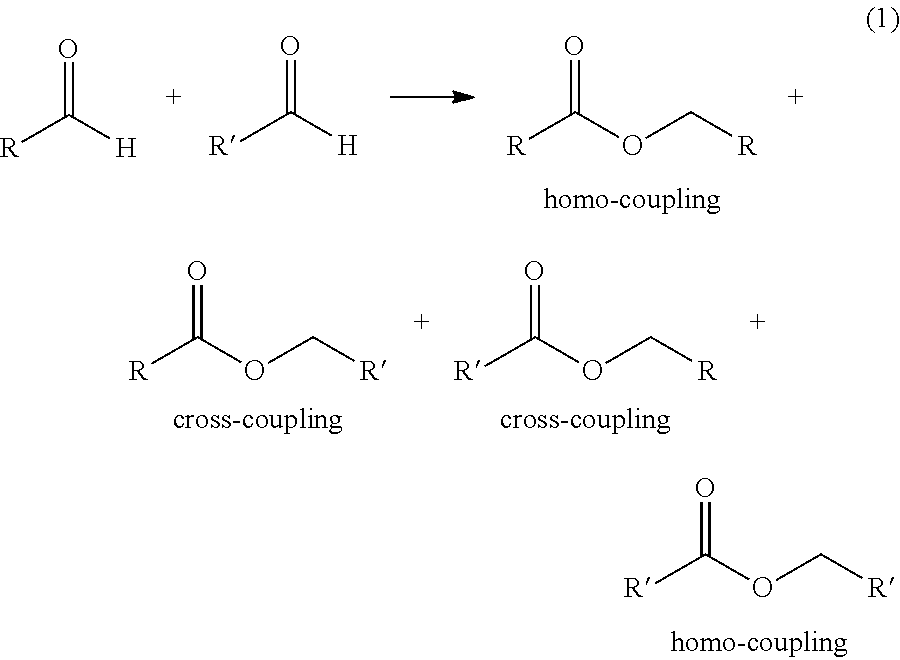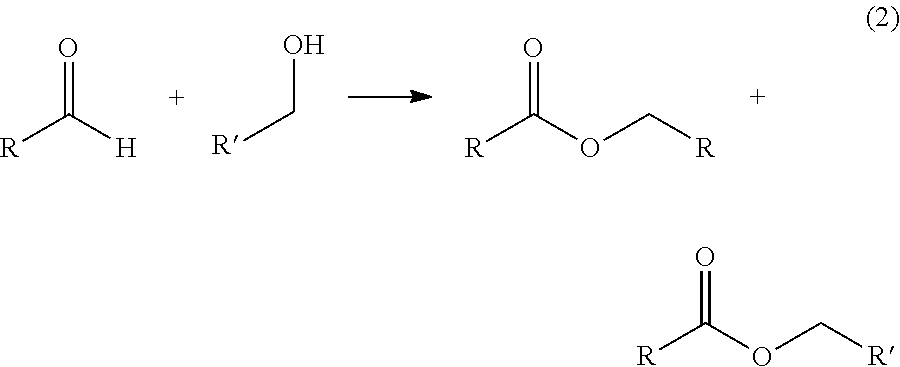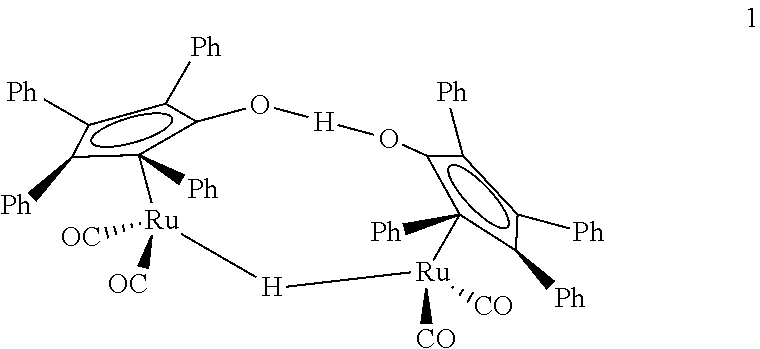Production of two esters using homogeneous catalyst
a technology of homogeneous catalyst and esters, which is applied in the preparation of carboxylic acid esters, chemistry apparatus and processes, and organic chemistry, etc., can solve the problem of no selective catalyst for a crossed-type, and achieve the effect of high conversion of the starting aldehyd
- Summary
- Abstract
- Description
- Claims
- Application Information
AI Technical Summary
Benefits of technology
Problems solved by technology
Method used
Image
Examples
example 1
[0050]A 50-mL autoclave was charged with 7.0 g (159 mmol) of AcH, 0.50 g (7 mmol) of n-butanol, 0.18 g (0.2 mmol) of Shvo's catalyst, and 14.6 g of toluene. The autoclave was pressurized with 200 psig of argon and was heated to 80° C. under continuous argon flow. It was kept at reaction temperature for 1 h, cooled to room temperature, and depressurized. The liquid product was analyzed by gas chromatography. Conversion and selectivity data are given in Table 1.
example 2
[0051]A 50-mL three-neck flask equipped with a condenser, a thermocouple, and argon purge line was charged with 7.0 g (159 mmol) of AcH, 1.5 g (7 mmol) of n-butanol, 0.65 g (0.6 mmol) of Shvo's catalyst, and 14.6 g of toluene. The flask was heated to 60° C. under continuous argon flow. It was kept at reaction temperature for 1 h, then cooled to room temperature. The liquid product was analyzed by gas chromatography. Conversion and selectivity data are given in Table 1.
example 3
[0052]A 50-mL three-neck flask equipped with a condenser, a thermocouple, and argon purge line was charged with 7.0 g (159 mmol) of AcH, 3.0 g (40 mmol) of n-butanol, 0.72 g (0.7 mmol) of Shvo's catalyst, and 14.6 g of toluene. The flask was heated to 60° C. under continuous argon flow. It was kept at reaction temperature for 1 h, then cooled to room temperature. The liquid product was analyzed by gas chromatography. Conversion and selectivity data are given in Table 1.
[0053]
TABLE 1Crossed-Tischenko Type Reaction of AcH and n-BuOHAcH ton-BuOHFeed% MoleTemp.AcH% SelectivityEx.Ratio(° C.)Conv.EABuOAcEtOHEtOBuNBNB1a23.680>99.9917.41.40.202b7.96098.482.214.43.30.203b46099.664.725.49.40.50.1a0.33 mol % catalyst loading.b0.10 mol % catalyst loading.
PUM
| Property | Measurement | Unit |
|---|---|---|
| molar ratio | aaaaa | aaaaa |
| temperature | aaaaa | aaaaa |
| temperature | aaaaa | aaaaa |
Abstract
Description
Claims
Application Information
 Login to View More
Login to View More - R&D
- Intellectual Property
- Life Sciences
- Materials
- Tech Scout
- Unparalleled Data Quality
- Higher Quality Content
- 60% Fewer Hallucinations
Browse by: Latest US Patents, China's latest patents, Technical Efficacy Thesaurus, Application Domain, Technology Topic, Popular Technical Reports.
© 2025 PatSnap. All rights reserved.Legal|Privacy policy|Modern Slavery Act Transparency Statement|Sitemap|About US| Contact US: help@patsnap.com



